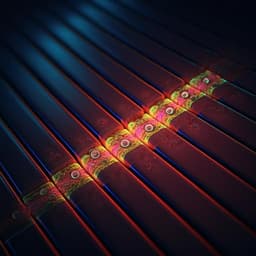
Engineering and Technology
A flexible pressure sensor with highly customizable sensitivity and linearity via positive design of microhierarchical structures with a hyperelastic model
Z. Xu, D. Wu, et al.
Discover a groundbreaking flexible pressure sensor designed by Zhenjin Xu, Dezhi Wu, Zhiwen Chen, Zhongbao Wang, Cong Cao, Xiangyu Shao, Gang Zhou, Shaohua Zhang, Lingyun Wang, and Daoheng Sun, offering customizable sensitivity and linearity. This innovative sensor is poised to revolutionize physiological signal recognition with remarkably low sensitivity errors and high linearity.
~3 min • Beginner • English
Introduction
The study addresses the challenge of achieving flexible tactile pressure sensors with customizable sensitivity across a required working range while maintaining high linearity. Traditional approaches often rely on passively inverting naturally occurring microstructural templates (e.g., pollen, petals, skin, abrasive paper, kirigami) or MEMS-fabricated artificial patterns to create sensitive layers. While these can enhance sensitivity and response by using regular microstructures (pyramids, microdomes) or modulus-tunable elastomers, they typically suffer from deformation saturation at higher pressures due to reduced compressibility of elastomers, limiting performance in high-pressure regimes. Moreover, passive strategies lack rational, quantitative design grounded in fundamental contact principles or models, leading to limited, non-targeted performance.
To overcome these limitations, the authors propose a positive design strategy rooted in hyperelastic mechanics tailored for large deformations of elastomeric sensitive layers. They note that many prior analyses used Hertzian elastic contact theory for qualitative insights, which is mismatched for hyperelastic materials and large strains, undermining predictability. The proposed modified hyperelastic contact model, benchmarked against FEA, enables accurate prediction of deformation parameters and microstructure distribution to realize targeted linear sensitivity over a specified working range. As a proof of concept, sensors are designed to achieve sensitivities of 0.7, 1.0, and 1.3 kPa−1 with linearity R2 ≈ 0.99 up to ~200 kPa, fast response/release (12.5/37.5 ms), low detection limit (35 Pa), and long-cycle stability (>10,000 cycles), demonstrating the feasibility and application potential (e.g., physiological signal recognition).
Literature Review
Prior work has enhanced pressure sensor performance by microengineering active layers with regular shapes such as pyramids and microdomes to increase compressibility and reduce viscoelastic effects in elastomers via modulus tuning. However, these approaches often encounter deformation saturation as pressure increases. Passive designs employing multiscale hierarchical microstructures derived from inverted natural templates (pollen grains, petals, human skin), abrasive papers, kirigami patterns, or MEMS-fabricated patterns have been introduced to promote continuous deformation. For instance, ordered multilevel microstructures with tuned radius and spatial distribution have been studied via simulation and experiments (e.g., by Geng et al.), but largely from qualitative or empirical perspectives without quantitative design rules. Some proactive strategies attempted rational assignment of gradient microdome architectures based on Hertzian contact (e.g., Zhou’s group) to design size and count, but reliance on Hertzian elastic contact yields model mismatch for hyperelastic materials undergoing large deformation, limiting predictive accuracy and making highly predictable performance elusive. This motivates a shift to hyperelasticity-based models for positive, demand-oriented design of microhierarchical structures.
Methodology
Design concept and sensing mechanism: Sensitivity is governed by changes in contact resistance dominated by the contact between the upper electrode and the conductive microstructured layer. Total resistance R ≈ Rc under load, as other resistances (electrode, bulk, lower contact) are much smaller and nearly constant. Sensitivity S is related to the contact area A: S = (ΔI/I0)/ΔP = ((A0 − A)/A0)/ΔP = (A/A0 − 1)/ΔP, implying sensitivity increases with contact area growth under pressure. The design aims to regulate a linear increase of contact area with pressure over a target working range.
Hyperelastic contact theoretical model: To capture large-deformation behavior of the elastomer, a neo-Hookean hyperelastic model (reduced from Mooney–Rivlin) is adopted. Key deformation parameters for a hemispherical pixel under compression are derived (inspired by sphere squeezing analyses): Δh = (1 − β) R*, Rc = R* sqrt(1 − αc^2), where β is the compression ratio of the overall height, R* is the initial hemisphere radius, and α, αc are the nominal height and tangential principal extension ratio at the contact surface. To avoid nonphysical zero limits (α or αc → 0) that render equations unsolvable, a preloading pressure (prestress from encapsulation) is introduced so α, αc > 0. The model is calibrated and checked against FEA to ensure accurate deformation predictions.
Hierarchical array design: For multistage hierarchical microstructures, the linear target sensitivity k over a working range WR and sensing area SA with total hierarchical orders TO is achieved by distributing sizes and counts of hemispherical pixels per stage. Define Sn as the contact area relation between adjacent stages and desired sensitivity: Sn = 1 + (n − 1) − k (n ≥ 2). Force balance across stages yields Fn = n(WR × SA)/TO and Fn = Σ_{i=1..n} m_i F_{n−i}, where m_i is the count of pixels contributing at each sub-stage and F_{n−i} is the component force per pixel. The total contact area Sn = Σ_{i=1..n} m_i π R_i^2. Compression heights in array conditions are determined recursively: Δh_n = (1 − β_n) R_n = (1 − β_n) R_{n−1} − Δh_{n−1} = ... = (1 − β_1) R_1 − Σ_{i=1..n} Δh_i, and radii update by R_n = R_{n−1} − Δh_n. Solving these simultaneously provides the target number m_n and radius R_n of pixels per stage to match the desired linear sensitivity over the working range.
Fabrication: Step I (design and material selection): Choose a conductive elastomer (MWCNT/PDMS composite) as the sensitive film and determine hyperelastic material constants from its stress–strain curve for use in the model. Define desired working range (e.g., up to ~200 kPa) and sensing resolution (e.g., per 10 kPa or 1 kPa), compute hierarchical orders and pixel distributions, and lay out the sensitive layer design accordingly (Tables S1–S4 in the source).
Step II (template and sensitive layer fabrication): 3D print (PµSL-based, ~10 µm precision) the microdome structures on a resin substrate per the design to form a convex master. Replicate into a thermoplastic polyurethane (TPU) concave mold to ease demolding and preserve shape. Cast and coat the MWCNT/PDMS solution onto the TPU mold to form the microstructured conductive film; cure and peel off.
Step III (sensor assembly): Sandwich the MWCNT/PDMS microstructured film between upper and lower flexible copper electrodes. Encapsulate using watertight polyurethane (PU) adhesive tape, which also imparts humidity insensitivity and introduces a small prestress (preload). Surface topology was verified by 3D surface scanning; SEM confirmed multistage protrusions with stage-wise distributions tailored for target sensitivities (0.7, 1.0, 1.3 kPa−1).
Key Findings
- The positive design strategy based on a hyperelastic contact model enabled pre-calculated microstructure distributions that achieved target linear sensitivities of 0.7, 1.0, and 1.3 kPa−1 over a wide linear working range up to ~200 kPa.
- Measured performance closely matched design targets with low error and high linearity: for the 0.7 kPa−1 target, measured sensitivity was 0.705 kPa−1 with linearity R2 = 0.989 and only 0.7% deviation from target. Sensors designed for 1.0 and 1.3 kPa−1 similarly met targets over 0–200 kPa (details in supplementary Figs. S4–S7).
- Compared to designs based on Hertzian contact, the hyperelastic model provided more accurate, predictable performance under large deformations and mitigated deformation saturation via antisaturation compensation embedded in the hierarchical design.
- Dynamic response: fast response and release times of 12.5 ms and 37.5 ms, respectively.
- Sensitivity floor: limit of detection (LOD) of 35 Pa.
- Durability and stability: consistent performance over >10,000 loading/unloading cycles; humidity-insensitive due to PU encapsulation.
- Application potential: demonstrated capability for physiological signal recognition; the approach supports demand-oriented tailoring of working ranges and linear sensitivity for wearable electronics.
Discussion
The proposed hyperelasticity-based positive design directly addresses the core challenge of tailoring sensitivity and linearity across a specified pressure range. By modeling the elastomeric microstructures with a neo-Hookean framework and enforcing stage-wise force/area balance, the method prescribes exact sizes and counts of hierarchical hemispherical pixels to yield a linear, pressure-proportional contact area change. This overcomes the limitations of passive template inversion and the model mismatch of Hertzian elastic contact for large strains. Experimental results validate the model’s predictability: sensors reached targeted sensitivities (e.g., 0.705 vs 0.7 kPa−1) with high linearity (R2 ≈ 0.99) across an extended 0–200 kPa range, while maintaining fast response, low LOD, and long-term cycling stability. The antisaturation behavior at predetermined pressures indicates effective management of elastomer compressibility reduction at higher loads. Collectively, the findings demonstrate that positive, model-driven design can produce scenario-specific sensors—balancing high sensitivity with broad range or prioritizing range over sensitivity—benefiting applications spanning electronic skin, health monitoring, and human–machine interfaces, including physiological signal recognition.
Conclusion
This work introduces a positive design strategy for flexible piezoresistive pressure sensors that leverages a hyperelastic contact model to predefine microhierarchical structures achieving customizable, linear sensitivity over a broad working range. The approach yields sensors with target sensitivities (0.7, 1.0, 1.3 kPa−1) and high linearity up to ~200 kPa, along with fast response, low detection limits, and robust cycling stability. Compared with Hertzian-based design, the hyperelastic model offers superior prediction under large deformations and mitigates saturation. The strategy enables demand-oriented sensor development with designable working ranges and linear sensitivities, supporting next-generation wearable and physiological monitoring applications. Future work may extend the framework to other microstructure geometries, materials, and broader pressure regimes, and integrate with diverse transduction mechanisms to further generalize the design paradigm.
Limitations
Related Publications
Explore these studies to deepen your understanding of the subject.







